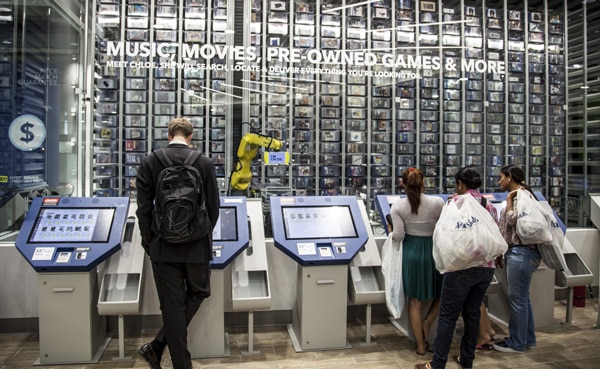Retail Leadership Skills of the Future
The future is already here – it’s just not evenly distributed.
William Gibson
The rapid acceleration of trends we’ve seen in the first half of 2020, thanks to COVID-19, prove Gibson right. The speed of adoption of new behaviours was only possible because the ideas and technologies applied already existed. This also applies to the changes experienced in the world of retail.
The increases in online shopping, click & collect and contactless payment during lockdown. The use of live video for beauty consultations. The proliferation of online advisors. All leveraged existing technologies. So it is not difficult to look around and identify the emerging technologies across the entire value chain in retail, from front-line customer experience to manufacturing and logistics. This can be as simple as looking at what well-resourced leaders in the field are trialling and scaling. An example is Woolworths’ introduction of the ‘scan & go’ technology first pioneered by Amazon Go in the US several years ago.
Senior executives in retail will need to prepare for how the roll-out of new technologies will require them to re-shape their teams. Capabilities will need to evolve, new skills developed. An area where impact will be greatest is with automation and AI technologies. There will be a decline in the demand for physical and manual skills, but an increase in the demand for social and emotional skills. It is important that retailers weigh up the social impact of redundancies. They must consider how they might minimise that impact in planning ahead. This means comprehensive strategies to re-skill existing workers – and to hire new workers against future-need criteria. This notion is as applicable to management and leadership roles as it is to front-line workers on shop-floors and in warehouses.
Retail Leadership Skills of the Future
Here’s a breakdown of the technical and interpersonal skills that will be essential to creating the retail talent pool of the future, particularly with an eye to leadership roles:
Tech-Literacy
At the risk of stating the obvious, a broad understanding of technology solutions that will increase efficiency and productivity is critical. One area that will benefit from technology is analytics. The time merchants and planners previously spent developing historical perspectives and forward scenarios can be greatly reduced through automation. This frees up their time to make better, more considered decisions and to work on other value-adding activities. Another area is HR, where new hiring technologies reduce the time to find and appoint talent whilst making more accurate matches.
Data Analysis
This is not just about being able to tap into the rich data that can be mined. It’s also about understanding what type of data can be scraped and crunched in order to produce new types of insights. Market-facing functions across marketing, product merchandising and sales must learn to partner with data engineers and analysts to extract the nuggets that will create competitive advantage.
Brand Management
Despite misguided claims to the contrary, branding has never been more important. As more consumers turn away from the mindless excessive consumption that fueled the rise of fast fashion, they are looking for more meaning and connection from the products they buy and the businesses they buy from. Post-pandemic economic conditions will certainly create increased price polarisation. More affluent consumers will stick with trusted and well-known premium brands and the more economically challenged will look increasingly towards home brands. But the reality today is that the best home brands have exceptionally strong brand attributes. The ability to find a unique space to occupy and a compelling story to tell will be paramount at all value tiers.
Category Management
Whilst FMCG and grocery retail have traditionally been much stronger in this space than other consumer goods categories, the time has come for all retail segments to develop the ability to analyse, segment, plan and price with a much higher level of sophistication and discipline. Fashion in particular has been weak in this area, where brands have failed to expand into new growth categories or divest of shrinking categories, and as a result have not created the diversification required to evolve with changing consumption patterns. Technology will certainly enable better category management, but it must be coupled with critical thinking and creativity.
Stakeholder-Centricity
The Retail industry was particularly slow to take up the notion of customer-centricity and plan their businesses around serving the needs of the stakeholder upon whom they most depend for success. And some appear to have still not quite grasped the concept. An example is the department stores who don’t provide the personalised service that customers crave (that they can’t get online). But just as they were beginning to get there, the goal-posts shifted again. In order to be successful in the new economy it is critical to consider the business’s deliverables to all stakeholders – certainly customers first, and shareholders, but also employees, suppliers, the community, the environment, government and regulatory authorities. Retail leaders who understand that key decisions must align and serve the needs of a broader group of stakeholders will create more resilient businesses. They must become adept at engaging in dialogue with all stakeholders, and maintaining a continuous pulse check on sentiment.
Empathy
This skill works hand-in-glove with Stakeholder-Centricity. This characteristic is the cornerstone of emotional intelligence, The ability to deeply listen to and understand the needs of key stakeholders is critical. This is more important than ever from an employee standpoint. The recent Black Lives Matter movement and the lambasting many retail brands received from current and former employees around their diversity practices is testament to this. The requirement for deep empathy is equally applicable to customers. As we move into an era of increased personalisation online, there will be an expectation, particularly from omni-channel brands, of a continuity of that personalisation on the retail floor. And whilst the technology we first saw in Minority Report back in 2002 does exist, and will certainly be further scaled in the coming decade, customers are looking for human interaction that creates real value in their physical shopping experience. Personal stylists, concierges and all customer-facing service roles will increasingly require this skill.
Growth-Mindset
One can argue that agility and adaptability are essential to working in retail, after all, it is the most change intensive of any industry. Take apparel retail for example. There is no other industry where a retailer will create and deliver tens of thousands of completely different and new skus every few months. Yet at the same time, many retailers have shown themselves to have a very fixed mindset. This is evidenced by how long it took them to embrace online as part of the channel mix. And in many other areas traditional retailers continue to be eclipsed by pure-play businesses who are born digital and embrace the notion of disrupting themselves through continuous innovation. The traditional retailers that will survive in the new economy will require talent with the ability to continuously innovate, and with the desire to continuously acquire and hone new skills.
Creativity
Whilst there are businesses who are already allowing algorithms to design future best-sellers, like subscription-box apparel retailer Stitch Fix, the need for creativity in retail will be greater than ever. It’s not unfathomable that a program can be created to replicate the level of unbridled creativity of a designer like Alessandro Michele for Gucci, yet the notion of it is likely unappealing to an audience who values the artist’s point of view. As technology becomes increasingly accessible through scale, it will no longer act as the only moat creating an unfair advantage. It’s at this point that retailers will need to bring to market a highly distinctive perspective, with a human story behind it. Creativity is essential not just in the design, product creation, branding and marketing functions, but also in terms of problem-solving and finding increasingly novel approaches to customer or market problems .

2019 saw three classic multi-brand e-commerce platforms reach billion-dollar valuations. It has been predicted that automation will disproportionately disrupt the retail segment. Whilst this generates exciting opportunities for evolution of the sector, it also creates an important responsibility for retail leaders to plan ahead to minimise the social impact. A longer-term plan needs to be developed for re-skilling staff, particularly those at entry-level who typically tend to have the lowest level of skill and will be most heavily impacted. This will undoubtedly require the involvement of government, community groups and educational institutions. It will require the re-skilling of workers for emerging roles both within and outside of the industry. The involvement of retail leaders in managing this momentous transition will in itself require the acquisition of new skills. They will need to learn to work with a new set of stakeholders to achieve important livelihood outcomes for their employees. 2019 saw three classic multi-brand e-commerce platforms reach billion-dollar valuations.
Those that remain in retail management roles will be operating in a very different environment, and a reliance on the skills of the past will put businesses at risk of disruption. Retail leaders must keep in mind that their most talented managers have a choice. Transferability of skills across sectors is more prevalent than ever. Sectors like financial services and tech invest heavily in learning and development programs. Retail must become more competitive in the development of their people to halt brain-drain to other sectors. The challenges ahead are many, particularly in this recessionary environment where costs must be tightly managed. Yet at the same time it is essential that retailers consider the critical investments they must make in skill development. Their survival depends on it.
This article was first published in Inside Retail. The author, Rosanna Iacono, is Managing Partner at The Growth Activists. With over 25 years experience in retail and consumer goods, including global leadership roles with multinationals Nike and Levis, and C-Level roles in Australia, Rosanna leads The Growth Activists Retail & Consumer Goods practice. To discuss your retail growth strategy get in touch with Rosanna at rosanna@growthactivists.com .




